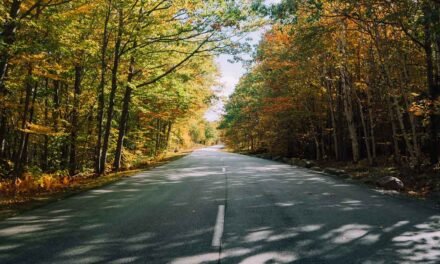Yosemite National Park is a wonderland of awe-inspiring landscapes and natural beauty that draws visitors from around the world. However, with four distinct seasons, the park’s character changes throughout the year, offering unique experiences and opportunities for exploration. In this blog post, we will discuss the advantages and disadvantages of visiting Yosemite during each season, touching on visitor numbers, weather, wildlife spectacles, flora, and more to help you determine the best time for your visit.
Spring: A Season of Waterfalls and Wildflowers
Visitor Numbers and Weather
Spring (March through May) is a fantastic time to visit Yosemite National Park. While visitor numbers begin to increase, the park is not as crowded as it is during the summer months. The weather is pleasant, with daytime temperatures ranging from 58°F to 70°F (14°C to 21°C). However, nighttime temperatures can still dip below freezing, so it’s essential to pack warm layers.
Rain and snow are possible during early spring, but as the season progresses, the likelihood of precipitation decreases. Due to snowmelt, waterfalls in the park are at their most spectacular, making this season a must for waterfall enthusiasts.
Wildlife and Flora
Spring in Yosemite is a time of rebirth and growth, with wildflowers carpeting the meadows and blossoming dogwoods adding splashes of color to the landscape. The Mariposa Grove of Giant Sequoias becomes accessible once again, providing a chance to witness these ancient trees in their full glory.
Wildlife is also abundant during spring, with black bears emerging from hibernation and deer, coyotes, and other mammals becoming more active. Birdwatchers will delight in the variety of species returning to the park, including migratory songbirds.
Summer: The Peak Season for Outdoor Activities
Visitor Numbers and Weather
Summer (June through August) is the busiest season in Yosemite National Park, with the highest number of visitors. The weather is warm and generally sunny, with daytime temperatures ranging from 73°F to 89°F (23°C to 32°C). Summer evenings are cooler, but temperatures rarely drop below 50°F (10°C).
Although the park can be crowded during this time, the vast majority of Yosemite’s facilities, campgrounds, and trails are open, providing ample opportunities for exploration and adventure.
Wildlife and Flora
Summer in Yosemite offers abundant opportunities for wildlife sightings, including black bears, mule deer, and smaller mammals like marmots and pikas. Birdwatchers can spot species such as the peregrine falcon, mountain bluebird, and western tanager.
The park’s meadows are verdant and filled with blooming wildflowers, such as lupines, Indian paintbrush, and Sierra lilies. Additionally, the alpine regions become accessible, allowing visitors to explore the higher elevations of the park and witness the unique flora and fauna that thrive there.
Fall: A Season of Color and Tranquility
Visitor Numbers and Weather
Fall (September through November) is a quieter time in Yosemite National Park, with visitor numbers decreasing significantly after the busy summer months. The weather during early fall is still pleasant, with daytime temperatures ranging from 66°F to 78°F (19°C to 26°C). However, as the season progresses, temperatures begin to drop, and the possibility of rain or even snow increases.
The park’s higher elevations, including Tioga Pass and Glacier Point Road, may close due to snow falling later in the season, so it’s essential to check road conditions before planning your trip.
Wildlife and Flora
Fall is a wonderful time to witness the changing colors in Yosemite National Park. The deciduous trees, such as black oaks, dogwoods, and quaking aspens, put on a dazzling display of reds, oranges, and yellows. This vibrant palette contrasts beautifully with the evergreen pines and firs, creating a breathtaking backdrop for your outdoor adventures.
Wildlife sightings are still possible during the fall, with black bears foraging for food to prepare for hibernation and mule deer becoming more active due to the mating season. Birdwatchers can spot species such as the Steller’s jay, American dipper, and northern pygmy-owl.
Winter: A Wonderland of Snow and Solitude
Visitor Numbers and Weather
Winter (December through February) in Yosemite National Park is the quietest season, with the lowest number of visitors. The weather is cold, with daytime temperatures ranging from 36°F to 48°F (2°C to 9°C), and nighttime temperatures often dropping well below freezing.
Snowfall is common, particularly at higher elevations, and many park facilities and roads, including Tioga Pass and Glacier Point Road, are closed for the season. However, the park’s beauty is undeniable during this time, as a blanket of snow transforms the landscape into a winter wonderland.
Wildlife and Flora
Winter in Yosemite offers a unique opportunity to experience the park’s quiet beauty, as well as to spot wildlife such as deer, coyotes, and foxes, which are easier to see against the snow. Birdwatchers can observe species such as the dark-eyed junco, American robin, and red-breasted nuthatch.
While the park’s flora is mostly dormant during winter, the snow-covered trees and frozen waterfalls create a magical atmosphere that is well worth experiencing.
Conclusion
Yosemite National Park is a stunning destination that offers unique experiences and opportunities for exploration during each season. Whether you’re captivated by the waterfalls and wildflowers of spring, the outdoor adventures and wildlife encounters of summer, the tranquility and vibrant colors of fall, or the snow-covered solitude of winter, Yosemite has something for everyone. Ultimately, the best season to visit Yosemite National Park depends on your personal preferences and the type of experience you’re seeking.



